Estratégia de mídia social do Duolingo: Qual é a eficácia dela? Relatório [2025]
Tabela de conteúdo
O Duolingo transformou completamente o aprendizado de idiomas e rapidamente se tornou o maior guru da mídia social. Conhecido principalmente por seu conteúdo humorístico no TikTok, ele criou conexões genuínas com usuários de todo o mundo e reuniu MILHÕES de seguidores.
O que faz com que a estratégia de mídia social do Duolingo se destaque? E que insights para outras marcas (e para você) essa abordagem oferece?
Vamos explorar o mundo de Duo, a coruja, e descobrir as respostas!
A estratégia de mídia social do Duolingo tem como foco a criação de conteúdo divertido, relacionável e envolvente. Eles criaram o mascote da marca, "Duo the Owl", que se tornou um superstar e mestre do marketing do TikTok. Eles usam várias plataformas e gostam de reutilizar seu conteúdo, o que definitivamente vale a pena. Seu desempenho na mídia social está em alta.
Analise o desempenho da sua mídia social!
Elementos-chave da estratégia de mídia social do Duolingo
Sem mentiras - eu mesmo admiro a mídia social do Duolingo.
Adoro o fato de que o sucesso da Duolingo nas mídias sociais não veio de grandes reuniões corporativas ou de planos de alto orçamento.
Em vez disso, tudo começou quando Zaria Parvez, de 23 anos, recém-formada, simplesmente perguntou se poderia fazer vídeos para a conta não utilizada da marca no TikTok.
Após uma análise detalhada do conteúdo e da atividade de mídia social deles, elaborei uma lista simples de cinco fatores que os fazem se destacar.
Esses são os 5 elementos principais da estratégia de mídia social do Duolingo:
- A personificação de "Duo, a Coruja".
O Duolingo tem uma coruja em seu logotipo e a criou como mascote de sua marca. Ela também se tornou o ponto central de seu conteúdo de mídia social. A dupla pode ser vista nas redes sociais da marca em várias cenas bem-humoradas e, às vezes, "desequilibradas". Ela conta uma história que repercute em um público amplo e torna a marca mais identificável.
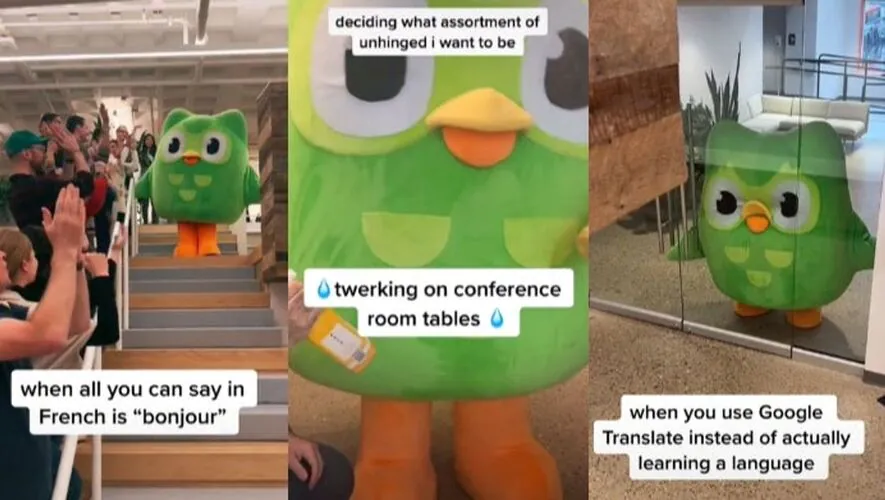
- Usando tendências.
O Duolingo não tem medo de se divertir on-line. Eles se divertem com os memes mais populares o tempo todo. Quando Selena e Hailey tiveram seu conflito aberto, eles recriaram esse drama e criaram sua própria "rixa" com o Google Translate.
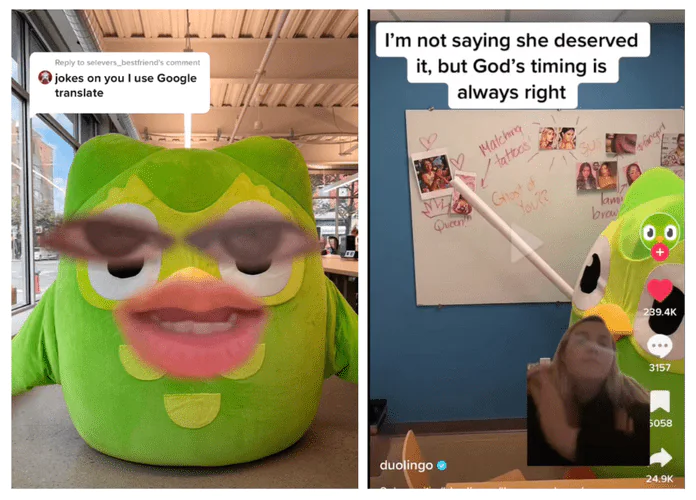
- Colaborações relevantes.
A questão aqui é a alta relevância - o Duolingo sempre os adapta para que se encaixem em seus valores e identidade. Isso mantém o conteúdo do Duolingo atualizado e consistente.
Por exemplo, você conhece o Squid Game da Netflix? Ao promover a segunda temporada, eles fizeram uma parceria com a Netflix para promover o aprendizado de coreano.
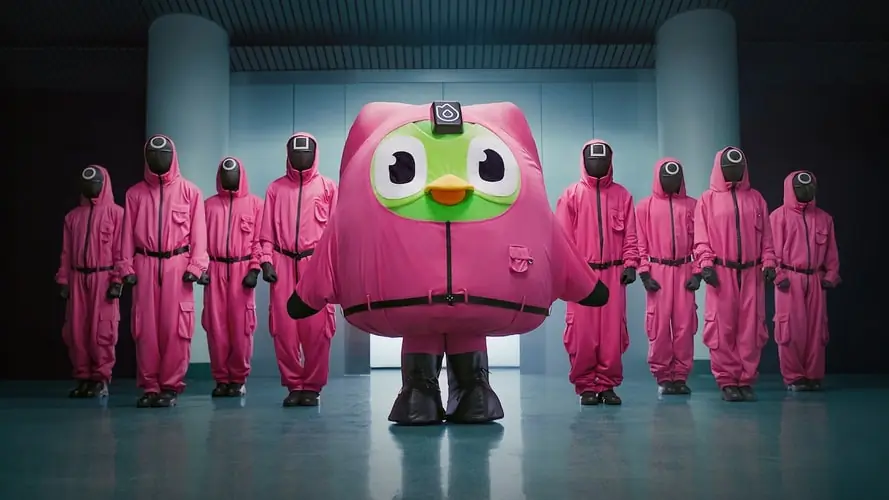
- Relacionamento genuíno com seu público.
O Duolingo sempre responde aos comentários e compartilha quando alguém mention os envia. Isso os ajuda a construir uma comunidade fiel que cria toneladas de conteúdo gerado pelo usuário.
Quero dizer... veja a resposta deles a este mention:
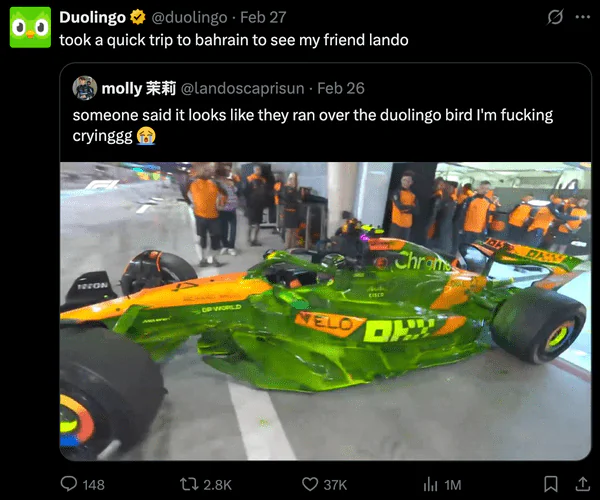
- Conteúdo humorístico e autêntico.
A marca adota um tom ousado e bem-humorado, compartilhando frequentemente conteúdo autoconsciente e divertido.
Às vezes, sua vibração sarcástica quase ultrapassa os limites. Mas eles ainda se equilibram no limite. Essa é exatamente a autenticidade que os usuários de mídia social procuram nas marcas.

- Usar vídeos curtos.
O conteúdo de vídeo curto tem um desempenho muito bom na realidade atual, em que as pessoas têm períodos curtos de atenção. O Duolingo combinou esse conhecimento com as possibilidades do algoritmo do TikTok e rapidamente conquistou um público bastante grande.
Além disso, eles publicam conteúdo de vídeo na maioria das plataformas.
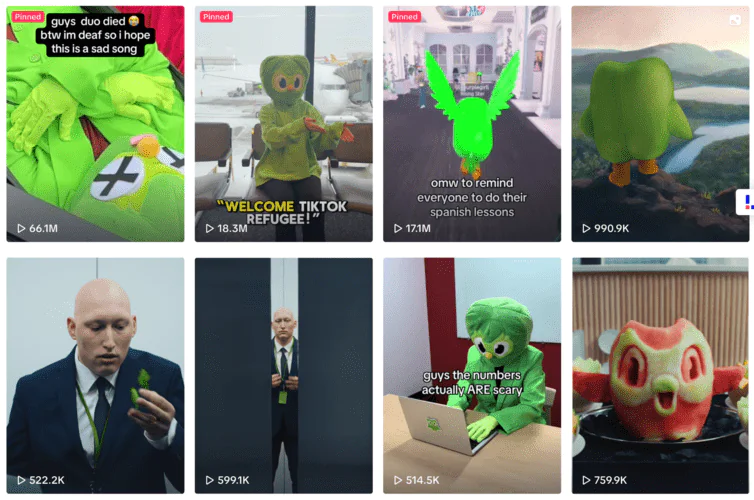
Em resumo, o conteúdo deles usa as possibilidades dos vídeos curtos em todo o seu potencial, com colaborações divertidas e modernas e um tom sarcástico e bem-humorado.
Ele se alinha perfeitamente com seu público-alvo, que é principalmente de jovens.
Obtenha insights sobre o desempenho da sua mídia social!
Principais conclusões da estratégia de marketing de mídia social do Duolingo:
Minhas observações me deram algumas conclusões:
- Conteúdo corajoso 💡
O Duolingo está sempre pronto para fazer experiências com o conteúdo. Isso definitivamente os diferencia. - Construção da comunidade 💪
Eles não apenas compartilham conteúdo - eles constroem relacionamentos em torno dele. O Duolingo frequentemente responde aos comentários de forma divertida e envolvente. - Adaptabilidade 🔥
O Duolingo é ágil na adoção de novas tendências e plataformas. Isso o mantém relevante e atraente tanto para os seguidores quanto para os novos públicos.
Encontre lugares para interagir com seu público!
Qual é a importância das plataformas de mídia social para o Duolingo?
As plataformas de mídia social são uma parte crucial da estratégia de marketing do Duolingo.
Eles permitem que a marca tenha um relacionamento próximo e mais informal com seu público.
O Duolingo usa plataformas de mídia social para realmente se envolver em conversas on-line.
Além disso, a mídia social é o lugar que deu vida própria ao Duo. Sem essas plataformas, não seria fácil criar um herói como esse de uma forma divertida, humana e identificável.
Monitore suas mídias sociais!
Análise do público-alvo e do envolvimento do cliente
No momento, o Duolingo tem os seguintes resultados:
- Instagram - 4 milhões de seguidores
- Facebook - 2,3 milhões de seguidores
- Twitter - 1 milhão de seguidores
- LinkedIn - 696 mil seguidores
- TikTok - 16,3 milhões de seguidores
- YouTube - 5,9 milhões de seguidores
Como você pode ver, a conta do TikTok é a de melhor desempenho.
Mais de 16 milhões de seguidores é uma loucura!
Mas isso não é nenhuma surpresa, pois toda a jornada de mídia social deles começou com isso.
Eles também têm ótimos números em outras plataformas de mídia social.
O LinkedIn tem o menor número de seguidores e, ao mesmo tempo, é a única plataforma abaixo da linha mágica de 1 milhão de seguidores.
Ok, esses números são ótimos, mas será que eles realmente geram engajamento?
Hoje em dia, o número de seguidores não é tão importante quanto costumava ser devido aos algoritmos.
Então, como está o engajamento do Duolingo nas mídias sociais?
O número médio de reações do perfil é de 178,2 mil curtidas e 1,7 mil comentários, o que representa uma taxa média de engajamento de 4,01%.
Eles publicam algumas vezes por semana e usam vários tipos de conteúdo, principalmente Reels.
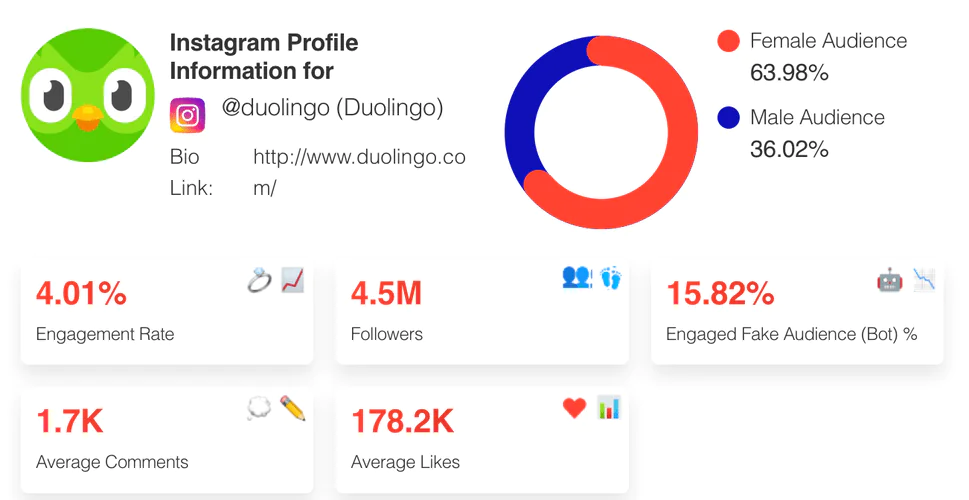
- TikTok
O número médio de reações do perfil é de 644,6 mil curtidas e 11,8 mil comentários, o que representa uma taxa média de engajamento de 4,03%.
Eles publicam quase todos os dias e também se envolvem com as publicações de outros usuários. Eles comentam quando alguém os mentions ou apenas quando se sentem relacionados.
Além disso, eles têm sua própria conta para diferentes idiomas, onde publicam conteúdo mais específico para cada cultura.
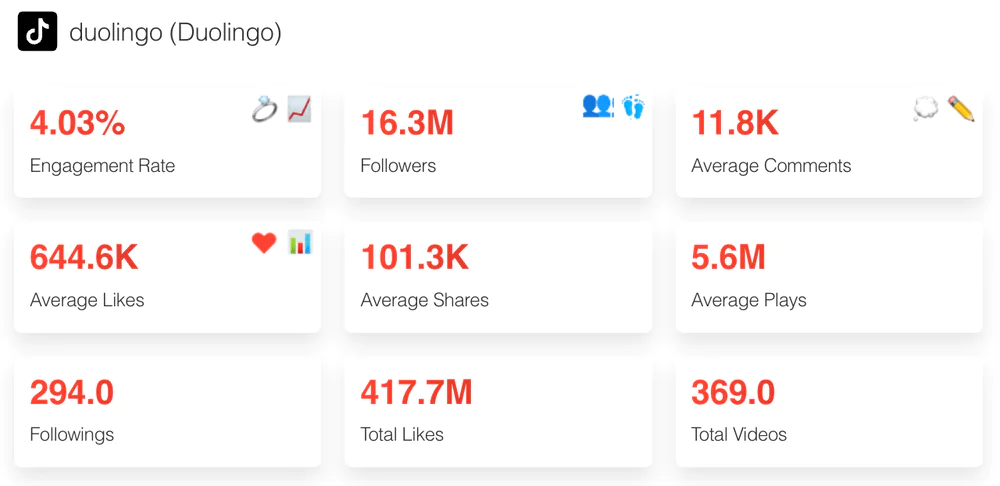
- X (Twitter)
O número médio de retweets é de 3,4 mil, o que representa uma taxa média de engajamento de 4,18%.
Eles postam lá algumas vezes por semana, e o conteúdo geralmente é engraçado: memes e retuítes da Geração Z.
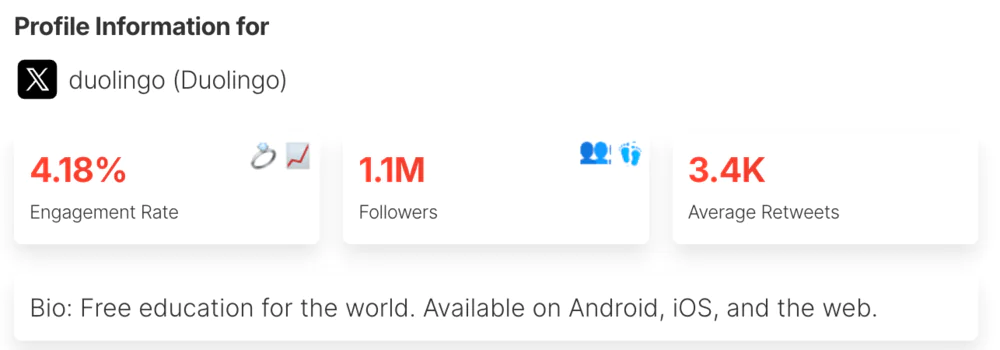
- YouTube
O número médio de reações ao perfil é de 76,5 mil curtidas, o que representa uma taxa média de engajamento de 7,43%. A parte interessante são os comentários - infelizmente, o zero se deve às limitações da ferramenta.
Eles publicam algumas vezes por mês e têm algum conteúdo do tipo "pessoas por trás de nosso produto".
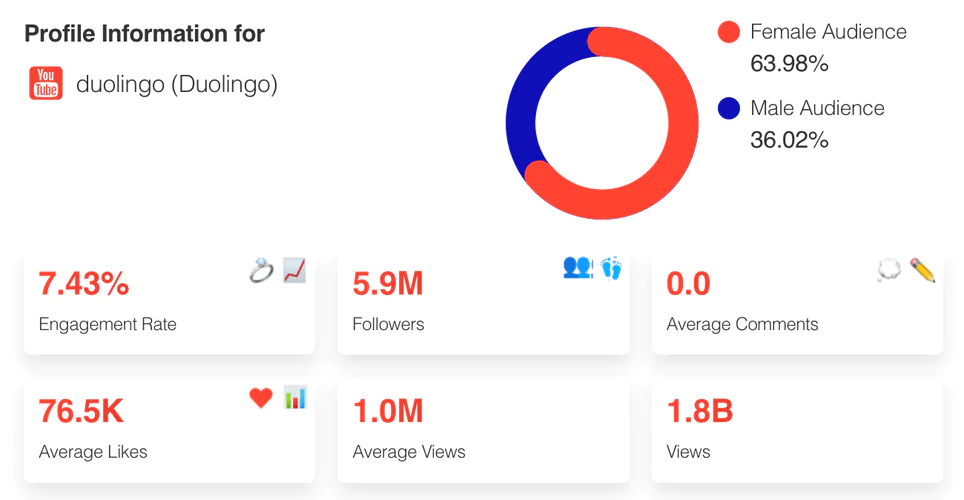
Fiz a análise acima usando um ferramenta de auditoria de mídia social - Influência.
Seus níveis de engajamento são impressionantes, sem dúvida!
Acho que isso também pode ser o resultado de como eles estão respondendo bem aos mentions.
Com as redes sociais sendo inundadas por anúncios e conteúdo pago, as pessoas adoram conexões genuínas e quando as marcas realmente prestam atenção a elas.
É aí que escuta social pode ajudar muito. Para a próxima análise, usei um ferramenta de escuta social, Brand24.
Interaja com seu público!
Dê uma olhada na análise dos mentions do Duolingo durante os últimos 30 dias:
- O Duolingo superou 87K mentions online.
- 82K deles vêm de mídia social.
- Eles obtiveram um total de 55 milhões de interações nas mídias sociais.
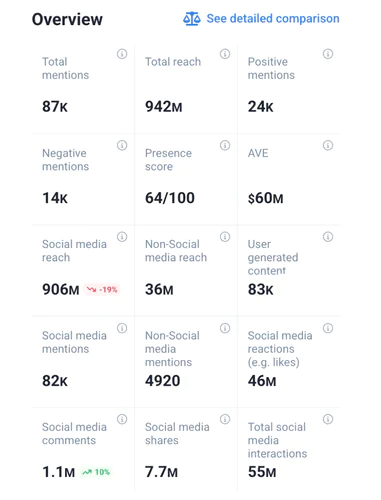
O que é surpreendente é que A maioria dos mentions de mídia social (68%) veio do X (Twitter). Isso pode ser devido à frequência com que a marca retweeta os mentions das pessoas e se envolve com elas.
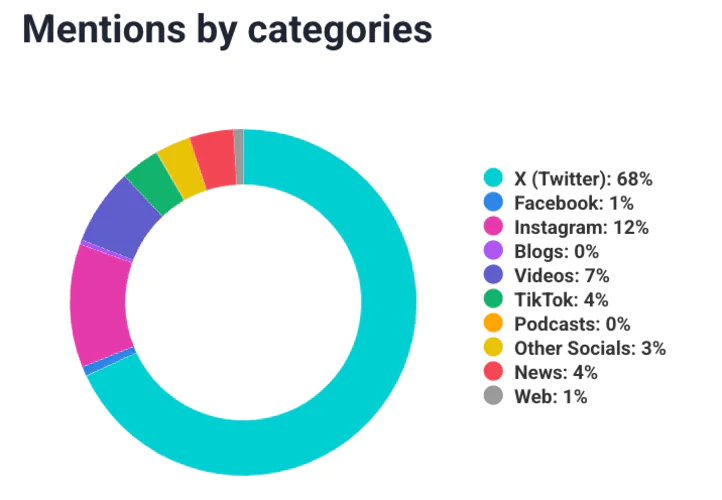
Obtenha uma análise da sua mídia social!
Análise do alcance da mídia social
Outra métrica crucial que precisamos considerar ao falar sobre o desempenho da mídia social do Duolingo é o alcance.
Alcance refere-se ao número total de usuários únicos que viram o conteúdo vinculado à marca.
Isso mostra diretamente o alcance da mensagem da marca on-line.
Em geral, o alto alcance aumenta visibilidade e reconhecimento da marca e potencial para atrair novos públicos.
E os mentions são essenciais para aumentar seu alcance.
Por quê?
Sempre que os usuários marcam ou falam sobre o Duolingo on-line, eles expõem a marca às suas redes. Essa exposição orgânica amplia a visibilidade da marca.
Encontre os mentions de sua marca!
- O mentions do Duolingo gerou uma estimativa de alcance de mais de 942 milhões.
- Absolutamente dominante é alcance de mídia social - mais de 906 milhões.
Esta é a aparência nos últimos 30 dias:

Você está vendo o pico no final de fevereiro?
Bem, é difícil não perceber isso. Verifiquei o que aconteceu naquela ocasião usando o recurso AI Events, e aqui está o resultado:

Esse foi o momento em que o Duolingo anunciou que a morte da Dupla era falsa.
Toda aquela campanha de morte foi uma obra-prima - as pessoas falavam muito sobre ela!
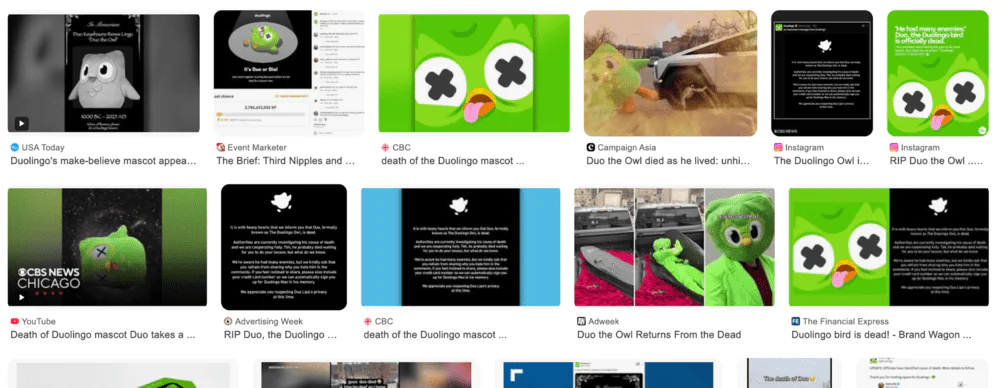
Analise o desempenho da sua mídia social!
Onde está a oportunidade para um alcance mais amplo?
O conteúdo de vídeo curto é um divisor de águas no marketing atual.
Isso nos permite alcançar novas pessoas sem custos adicionais.
O Duolingo usa o conteúdo de vídeo em todo o seu potencial. Eles os publicam regularmente no TikTok, YouTube e Instagram.
Eles também reutilizam seu conteúdo e publicam o mesmo vídeo em diferentes plataformas.
Essa é uma ótima estratégia!
O mesmo conteúdo pode se tornar viral em uma plataforma e ser um desastre completo em outra. Reutilizá-lo aumenta as chances de se tornar viral.
Veja um exemplo:
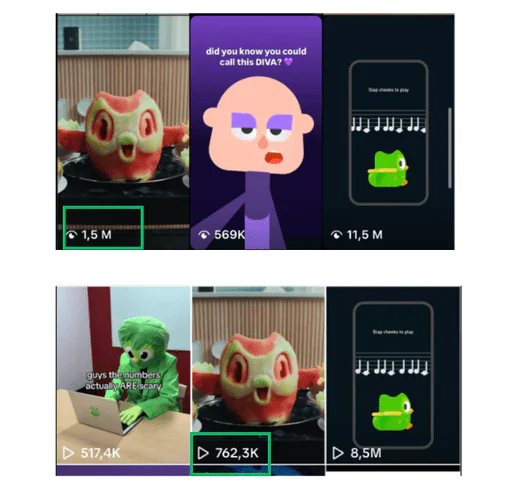
Embora o Duolingo tenha muito mais seguidores no TikTok, quando eles publicaram o mesmo vídeo no TikTok e no Instagram, o vídeo postado no Instagram teve um desempenho melhor.
Por outro lado, parece que O Facebook continua sendo a plataforma com o pior alcance.
O Duolingo está fazendo o melhor que pode e tentando publicar Reels lá, mas eles ainda não recebem muita atenção em comparação com outras plataformas.
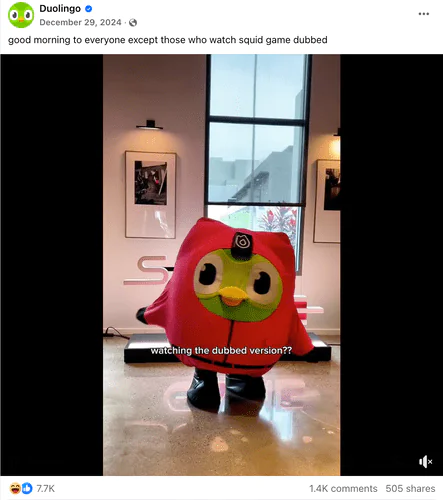
Saiba onde colocar seus esforços!
Análise do sentimento do Duolingo
Vamos passar para a análise de sentimentos do Duolingo.
Análise de sentimento é um processo que avalia o tom emocional por trás dos mentions on-line de uma marca.
Ele as categoriza como:
- Positivo 🟢
- Negativo 🔴
- Neutro ⚪️
O monitoramento do sentimento ajuda as marcas a entender como elas são percebidas pelo público.
Quando se trata do Duolingo, o sentimento geral é amplamente positivo.
Nos últimos 30 dias, a marca recebeu 24K positivos mentions e 14K negativo mentions.
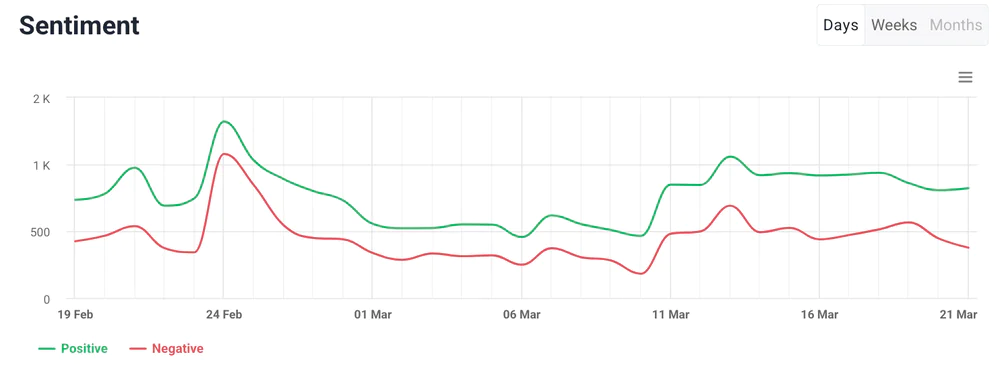
O Brand24 também nos permite identificar quais plataformas são responsáveis pelos mentions mais negativos.
Analise o sentimento de sua marca!
Verifiquei o Duolingo, e a grande maioria - mais de 11 mil mentions negativos, veio de Twitter:
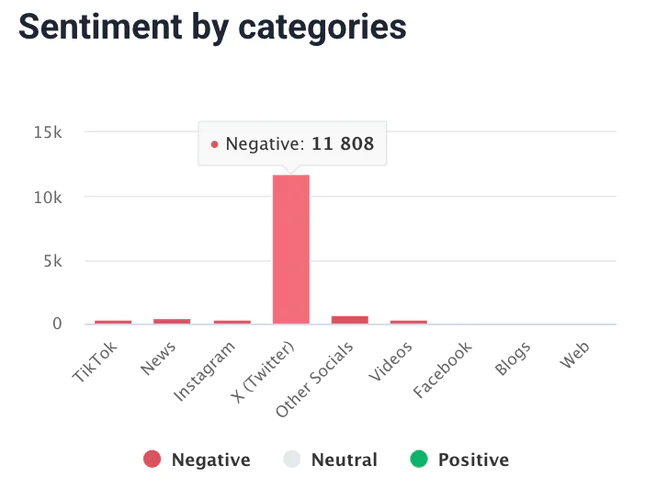
Apesar da presença de comentários negativos, o sentimento em torno do Duolingo é estável e geralmente favorável.
Lembre-se de que mentions negativos têm grande valor. São insights sobre as necessidades e expectativas dos clientes.
Assim como a imagem abaixo. Talvez o Duolingo possa resolver esses problemas de congelamento?

Encontre feedback valioso dos clientes!
Análise da concorrência: Duolingo vs. Babbel
Está claro que O Duolingo supera significativamente o desempenho da Babbel em quase todas as métricas.
- O Duolingo tem Total de 85 mil mentionsem comparação com apenas 3,2 mil para a Babbel.
- Especificamente nas mídias sociais, o Duolingo gerou 80K mentionsenquanto a Babbel tinha apenas 1.4K.
O mesmo domínio é visível no alcance:
- O Duolingo alcançou um alcance de mídia social de 820 milhões Babbel's 13M.

A análise de sentimento prova que ambas as marcas são vistas principalmente em uma perspectiva positiva:
- O Duolingo tinha 23 mil mentions positivos (28%) e 13 mil mentions negativos (16%)
- A Babbel tinha 747 mentions positivos (23%) e somente 277 mentions negativos (9%)
Essa análise mostra que a Babbel recebe um pouco menos mentions negativos (proporcionalmente).
Mas precisamos ter em mente que o volume e a visibilidade dos mentions do Duolingo são muito maiores, tornando-o mais exposto a críticas.
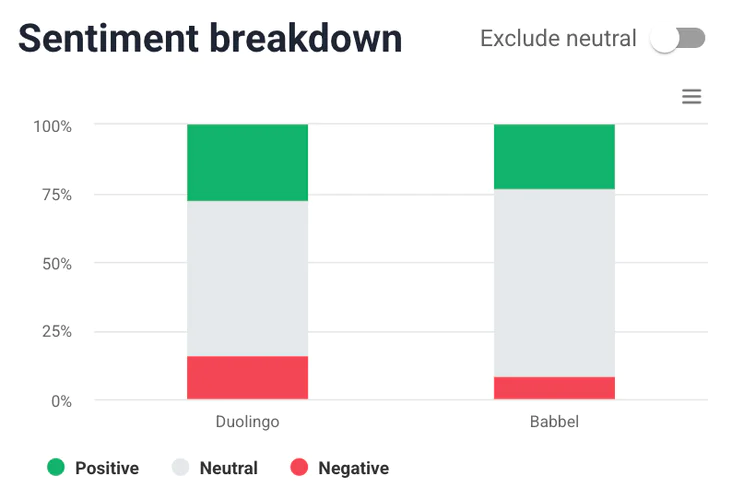
Compare com os concorrentes!
5 coisas que podemos aprender com o Duolingo
Para resumir toda essa análise, como você pode usar esse insight para melhorar sua estratégia de mídia social?
Aqui estão as 5 principais lições a serem lembradas:
1. Estabeleça um relacionamento com seu público
O Duolingo não criou apenas um personagem. Eles deram ao Duo uma personalidade real. Eles transformaram seu mascote em um "personagem" relacionável que torna a marca mais próxima do público. Certifique-se de se concentrar em uma conexão genuína, em vez de promover mais e mais conteúdo com o qual ninguém se importa.
2. Use as tendências com sabedoria
A equipe social do Duolingo é sempre por dentro das últimas tendências. Huh! Acho que eles até criaram alguns deles! Eles os remixam de maneiras inesperadas ou ajustam seu conteúdo às tendências culturais. Participe das tendências, mas sempre garanta a relevância delas para a identidade e os valores de sua marca.
3. Foco no engajamento
Em vez de simplesmente divulgar conteúdo, o Duolingo se envolve com seus seguidores. Seja compartilhando tweets, respondendo a comentários ou repostando conteúdo do usuário - sua comunidade pode se sentir valorizada e vista. Quando foi a última vez que sua marca respondeu a um seguidor? Talvez seja hora de mudar isso.
4. O vídeo de formato curto (ainda) é rei
O Duolingo usou o TikTok e o resultado obtido mostra que vídeos curtos e envolventes são o formato mais eficaz no marketing de mídia social atual. Isso possibilita alcançar novas pessoas de forma orgânica. Com que frequência você publica Reels?
5. A autenticidade compensa
A maioria das empresas teria pavor de publicar algo peculiar ou fora do comum. Mas o Duolingo? Eles mergulham de cabeça no caos, e seu público os adora por isso. Não tenha medo de fazer de sua marca "algo", marcas vazias passam despercebidas.
Analise o desempenho da sua mídia social!
Conclusão
Será que todo esse sucesso de mídia social do Duolingo é uma coincidência?
Acho que não.
É uma mistura de autenticidade, agilidade e criatividade ousadamais uso inteligente de dados.
Sua estratégia prova que uma marca não precisa de um orçamento enorme para se tornar viral, apenas um profundo entendimento do público e a coragem de experimentar.
Deseja realizar uma análise semelhante para sua marca? Comece com a avaliação gratuita do Brand24 e desbloqueie o poder do listening social!




